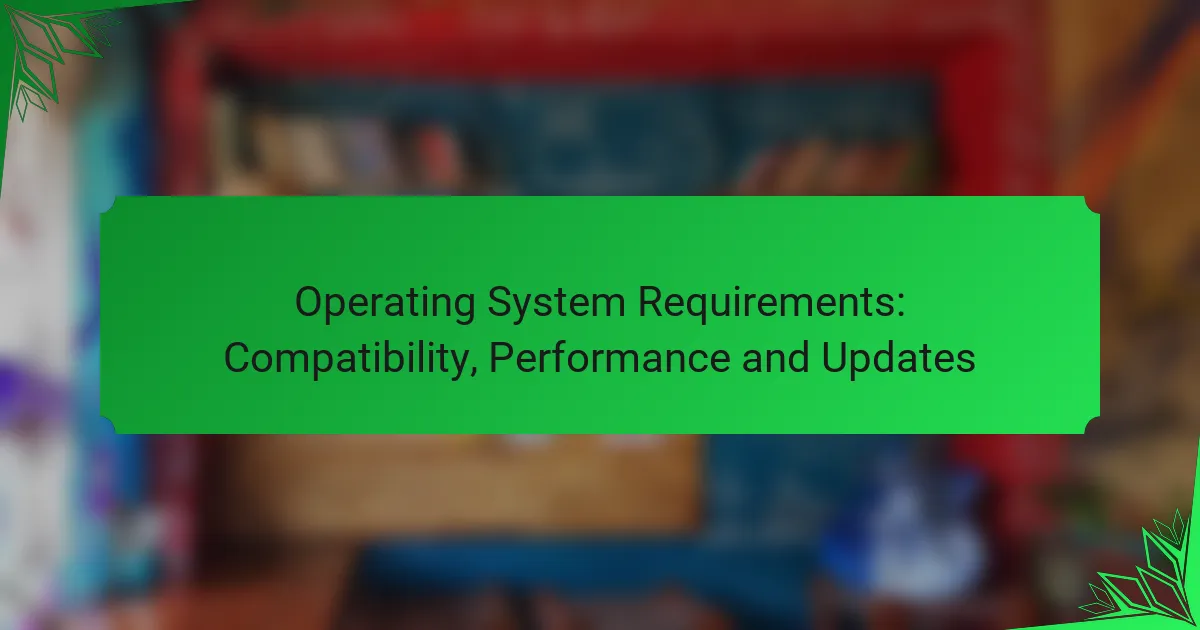Operating system requirements are crucial for ensuring that both hardware and software work seamlessly together, allowing users to run applications efficiently and maintain system stability. By understanding the minimum specifications and compatibility factors, users can avoid potential performance issues and installation failures, leading to a smoother computing experience.

What Are the Key Operating System Requirements?
Key operating system requirements encompass the minimum hardware specifications, supported software versions, and system architecture compatibility necessary for optimal performance. Understanding these requirements ensures that users can effectively run applications and maintain system stability.
Minimum hardware specifications
Minimum hardware specifications refer to the essential components required for an operating system to function properly. Typically, this includes a certain amount of RAM, a specific processor speed, and adequate storage space. For example, many modern operating systems require at least 4 GB of RAM and a dual-core processor.
When considering hardware, it’s crucial to account for the demands of the applications you plan to run. Higher performance applications may necessitate more powerful hardware, such as 8 GB of RAM or faster processors, to ensure smooth operation.
Supported software versions
Supported software versions indicate which versions of applications and drivers are compatible with the operating system. Each OS version typically has a list of applications that are certified to work without issues. For instance, certain productivity suites may only function correctly on the latest OS updates.
To avoid compatibility problems, regularly check for updates from both the operating system and application developers. This helps ensure that you are using software that is fully supported and can leverage the latest features and security enhancements.
System architecture compatibility
System architecture compatibility refers to the alignment between the operating system and the underlying hardware architecture, such as x86 or ARM. An operating system designed for x86 architecture will not run on ARM devices, and vice versa. Understanding this compatibility is essential when selecting hardware for your OS.
When upgrading or purchasing new hardware, verify that the system architecture matches the operating system requirements. This will prevent installation issues and ensure that the system operates efficiently without unnecessary complications.

How to Check Compatibility with Your Hardware?
To check compatibility with your hardware, first identify your system specifications and then compare them with the requirements of the operating system you wish to install. This process ensures that your hardware can support the OS effectively, avoiding performance issues or installation failures.
Using built-in system tools
Most operating systems come with built-in tools that can help you assess compatibility. For example, Windows users can utilize the “System Information” tool to view details about their hardware configuration, including processor type, RAM, and available storage. On macOS, the “About This Mac” feature provides similar insights.
To use these tools, simply search for them in your system settings or applications. Make a note of your hardware specifications and compare them against the minimum requirements listed by the OS vendor.
Third-party compatibility checkers
Third-party compatibility checkers can provide a more comprehensive analysis of your hardware’s ability to run a specific operating system. Tools like CPU-Z or Speccy can give detailed reports on your system’s components, helping you identify potential issues.
When using these tools, ensure they are from reputable sources to avoid security risks. After gathering the information, cross-reference it with the OS requirements to determine if your hardware meets the necessary standards.

What Are the Performance Metrics to Consider?
When evaluating operating system performance, key metrics include CPU usage, memory consumption, and disk I/O performance. These metrics help determine how efficiently the OS utilizes hardware resources, impacting overall system responsiveness and user experience.
CPU usage benchmarks
CPU usage benchmarks measure how much processing power an operating system consumes during various tasks. High CPU usage can indicate that the OS is struggling to manage applications effectively, leading to slowdowns. Aim for CPU usage to stay below 70% during regular operations to ensure smooth performance.
Common tools for measuring CPU benchmarks include built-in task managers and third-party applications like CPU-Z or HWMonitor. Regular monitoring can help identify processes that may be consuming excessive resources, allowing for optimization or troubleshooting.
Memory usage statistics
Memory usage statistics reflect how much RAM an operating system is utilizing at any given time. Efficient memory management is crucial, as excessive usage can lead to system slowdowns or crashes. Ideally, an OS should use around 50-70% of available RAM during typical workloads.
Tools like Windows Resource Monitor or macOS Activity Monitor can provide insights into memory consumption. If memory usage consistently exceeds 80%, consider upgrading RAM or optimizing running applications to improve performance.
Disk I/O performance
Disk I/O performance gauges how quickly data can be read from or written to storage devices. Slow disk I/O can significantly hinder system performance, especially when launching applications or loading files. Look for read/write speeds in the range of 100-500 MB/s for solid-state drives (SSDs) and 50-150 MB/s for traditional hard drives (HDDs).
Monitoring tools like CrystalDiskMark or HD Tune can help assess disk performance. If I/O speeds are below expected levels, consider defragmenting HDDs or upgrading to SSDs for improved responsiveness and efficiency.

How to Optimize Operating System Performance?
To optimize operating system performance, focus on adjusting system settings, updating drivers and software, and utilizing performance monitoring tools. These steps can significantly enhance speed and efficiency, ensuring your system runs smoothly.
Adjusting system settings
Adjusting system settings can lead to noticeable performance improvements. Start by disabling unnecessary startup programs, which can reduce boot time and free up system resources. Additionally, consider adjusting visual effects to prioritize performance over aesthetics.
Another key adjustment is to manage power settings. For desktops, using a high-performance power plan can enhance responsiveness, while laptops may benefit from a balanced plan to extend battery life without sacrificing too much speed.
Updating drivers and software
Keeping drivers and software up to date is crucial for optimal operating system performance. Regular updates can fix bugs, improve compatibility, and enhance security. Check for updates at least once a month to ensure all components are functioning efficiently.
Utilize built-in update tools provided by your operating system, such as Windows Update for Windows users or Software Update for macOS. Additionally, consider using manufacturer websites for specific hardware drivers to get the latest versions directly.
Using performance monitoring tools
Performance monitoring tools can provide valuable insights into how your operating system is performing. Tools like Task Manager on Windows or Activity Monitor on macOS allow you to track resource usage and identify any applications that may be consuming excessive CPU or memory.
For more detailed analysis, consider third-party applications that offer advanced monitoring features, such as real-time performance tracking and historical data analysis. These tools can help you pinpoint issues and optimize system performance effectively.

What Are the Update Requirements for Operating Systems?
Update requirements for operating systems include regular security patches, feature updates, and adherence to end-of-life support timelines. These updates are crucial for maintaining system security, improving performance, and ensuring compatibility with new software and hardware.
Regular security patches
Regular security patches are essential updates that address vulnerabilities in the operating system. These patches are typically released monthly or as needed, depending on the severity of the security issues discovered. Users should enable automatic updates to ensure their systems are protected against the latest threats.
For example, Microsoft Windows often releases “Patch Tuesday” updates, while Linux distributions may provide patches as they are developed. Failing to apply these updates can leave systems exposed to malware and cyberattacks.
Feature updates and enhancements
Feature updates and enhancements introduce new functionalities and improve existing features of the operating system. These updates can occur semi-annually or annually, depending on the OS. Users should consider the benefits of new features against the potential need for system reconfiguration or learning new interfaces.
For instance, Windows 10 and 11 receive major updates that may include new security features, user interface changes, or performance improvements. Users should review update notes to understand what changes will affect their workflow.
End-of-life support timelines
End-of-life (EOL) support timelines indicate when an operating system will no longer receive updates or support from the vendor. It is crucial for users to be aware of these timelines to avoid using outdated systems that lack security updates. Typically, major operating systems provide several years of support before reaching EOL.
For example, Windows 7 reached EOL in January 2020, meaning users were encouraged to upgrade to a newer version to maintain security. Staying informed about EOL dates helps users plan upgrades and avoid potential risks associated with unsupported software.

How Do Operating System Updates Affect Compatibility?
Operating system updates can significantly impact software compatibility, often introducing new features or security enhancements that may not work well with older applications. Users should be aware that while updates can improve performance, they may also lead to issues with legacy software and drivers.
Impact on legacy software
Legacy software, which refers to older applications that may not be actively maintained, can face compatibility challenges with new operating system updates. These updates may change system libraries or APIs that the legacy software relies on, potentially causing it to malfunction or crash.
For example, a business using a decades-old accounting program might find that after an OS update, the application no longer launches or behaves unpredictably. It’s advisable to test critical legacy applications in a controlled environment before fully deploying any OS updates.
Driver compatibility issues
Driver compatibility is another critical area affected by operating system updates. Drivers, which allow the OS to communicate with hardware devices, may become outdated or incompatible after an update, leading to hardware malfunctions or reduced performance.
For instance, after updating to a new version of Windows, users might find that their printer or graphics card no longer functions correctly. To mitigate this, check the manufacturer’s website for updated drivers before performing an OS update, and consider delaying the update if critical drivers are not yet available.
